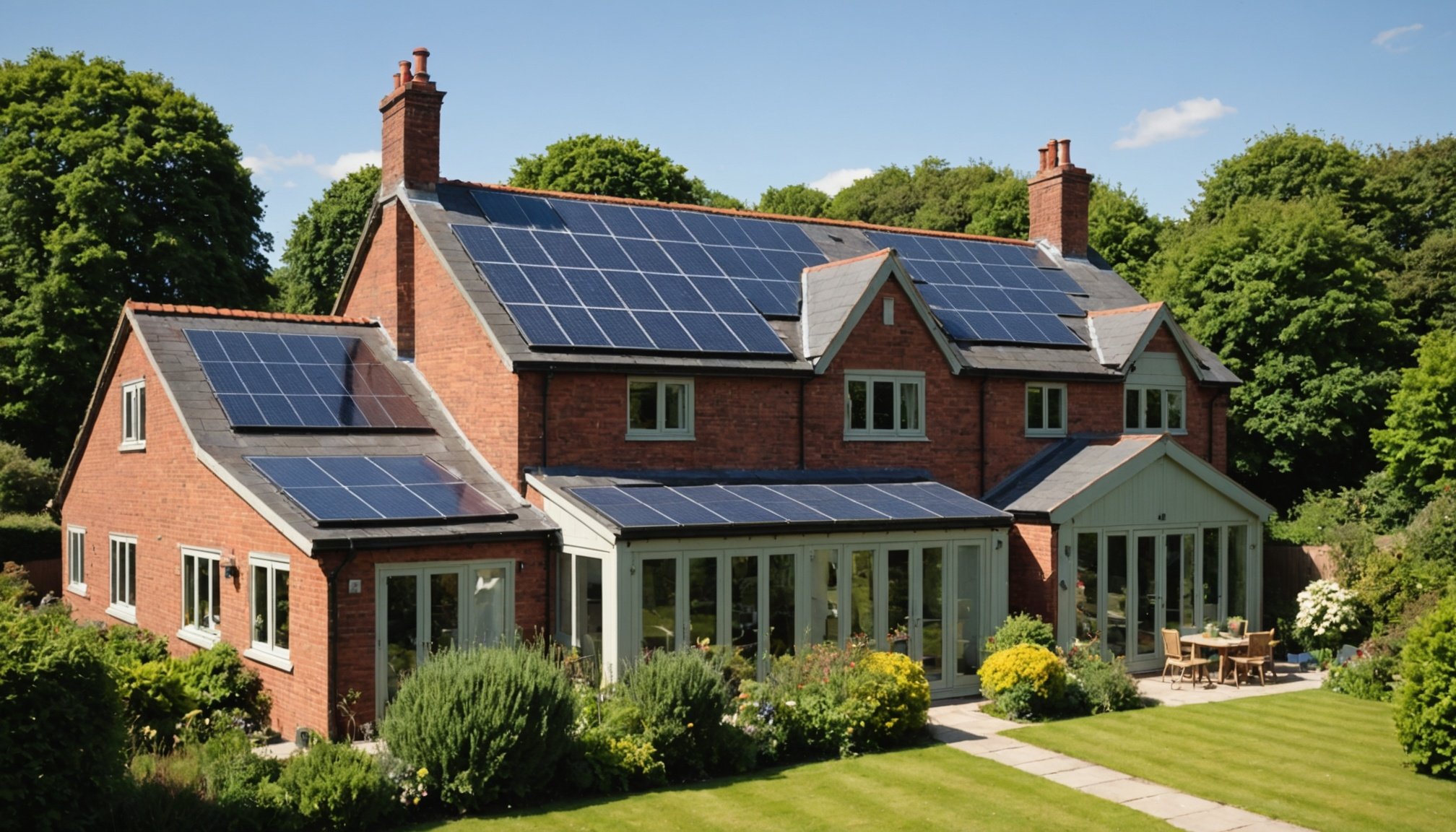Overview of Solar Energy Solutions for Heritage Homes
Exploring solar energy for heritage properties opens avenues for reducing carbon footprint while retaining historic charm. Emphasising integration of solar solutions is critical to ensure that the green initiative complements the architectural essence of these homes. The challenge lies in balancing sustainability with style, creating renewed energy in historic homes without compromising their legacy.
Key to adopting solar energy in such contexts is respecting regulations governing these historic sites. Heritage properties are often protected by strict regulations to maintain their architectural integrity. Engaging with local planning authorities is vital to discern the limitations and possibilities for solar installations. Each heritage home may confront unique restrictions, making personalised consultation crucial.
Have you seen this : Securing Britain’s Tomorrow: Cutting-Edge Solutions for Flood Risk Management
The integration process involves selecting solar technologies that blend seamlessly with existing structures. For instance, solar tiles are designed to mirror traditional roofing, offering a discreet alternative to standard panels. Specialist contractors familiar with historic architecture can provide invaluable insight here, ensuring both aesthetics and efficiency are preserved.
Recognising these elements, heritage home owners can embrace solar solutions to achieve energy independence and heightened property value. By aligning renewable energy initiatives with architectural preservation, solar energy paves the way for a sustainable future while cherishing the past.
Have you seen this : Revamping Your Home: Designing Versatile Spaces for Your Growing Family’s Needs
Understanding Regulations and Compliance
Navigating the landscape of compliance for heritage homes requires a diligent exploration into solar regulations in the UK. Heritage properties are safeguarded by stringent policies aimed at preserving their historical essence. Before any solar installation, it’s paramount to attain necessary planning permissions. Each project must adhere to guidelines formulated by local councils and national heritage bodies to ensure architectural integrity is maintained.
Key regulations impacting solar installations often involve assessments of visual impact, ensuring that solar energy adaptations do not detract from the historic aesthetics. Engaging with local planning authorities aids in comprehensively understanding these requirements and crafting suitable solutions. Successful navigation of compliance challenges has been exemplified in numerous case studies across the UK.
For instance, some heritage homes have effectively embedded innovative solar technologies without compromising their traditional façade. Such achievements underscore the importance of early consultation and strategic planning. By understanding regulations, homeowners can align their green initiatives with conservation ideals, ensuring the integration of solar solutions respects both regulatory and aesthetic demands. This approach provides a roadmap for blending sustainability with heritage conservation.
Best Practices for Seamless Integration
Incorporating solar installation best practices is essential for adapting modern technology to heritage homes while upholding their architectural charm. Achieving architectural harmony involves creatively aligning solar solutions with traditional aesthetics. Here are strategies to consider:
-
Innovative solar panel designs: Using alternatives like solar shingles or thin-film panels can seamlessly merge with existing roofing structures. These options replicate classic materials, ensuring the historical appearance is maintained while embracing green energy.
-
Engage specialists: Employ contractors or specialists experienced in both solar technology and historic building conservation to enable a smooth transition. Their expertise helps navigate restrictions and preserve the site’s integrity.
Balancing new technology with historical aesthetics involves careful planning. Each adjustment should be unobtrusive, ensuring that heritage properties continue to visually engage and inspire. Modern solar panels shouldn’t overshadow the rich historical narratives these structures embody.
Furthermore, nurturing a dialogue between solar technology and heritage conservation experts can open new paths for heritage home adaptations. This collaboration aids in identifying solutions that respect both sustainability goals and cultural preservation. With thoughtful integration, heritage homeowners can enjoy the benefits of solar energy without compromising the essence of historical architecture.
Benefits of Solar Energy for Heritage Homes
Exploring the advantages of solar energy for heritage homes unveils a spectrum of benefits that extend beyond mere environmental impact. Embracing solar solutions significantly contributes to sustainability in historic properties by reducing the traditional energy consumption associated with these homes. This not only aligns with global sustainability goals but also empowers homeowners to achieve energy savings as renewable solutions minimize dependency on fossil fuels.
The financial incentives accompanying solar energy adoption offer a tangible advantage. Many countries, including the UK, provide subsidies and tax benefits to encourage the transition to green technology, leading to substantial long-term savings for homeowners. Such incentives can significantly offset initial installation costs, making solar energy a viable, economical option.
Moreover, integrating solar technology can enhance property value. Prospective buyers often value eco-friendly initiatives, seeing them as investments in future energy independence and reduced utility costs. This green evolution of heritage homes does not merely respect the past but also secures a sustainable future.
Emphasizing energy independence through solar installations allows heritage homeowners to forge a path towards a resilient lifestyle. Each kilowatt produced from their own roofs lessens reliance on traditional energy sources, heralding a future where sustainability and historical preservation coexist harmoniously.
Installation Process of Solar Solutions
Integrating solar panel installation into heritage homes involves distinct steps to marry new technology with old-world charm effectively. Success hinges on meticulous planning and cognizant execution.
Step-by-Step Execution:
-
Initial Assessment and Design: Begin by evaluating the structural stability of the roof and determining the most suitable solar technology for your home. Consider devices that complement the home’s architectural nuances.
-
Seek Permissions: Obtain necessary approvals from local authorities, ensuring compliance for heritage homes is attained. Permissions vary, so it’s crucial to have local guidance on these procedures.
-
Partner with Experts: Engage contractors skilled in heritage conservation. Their dual expertise in solar solutions and historical structures safeguards against compromising architectural integrity.
-
Installation: Utilize non-invasive mounting systems that respect the building’s fabric. Attention to detail in aligning panels with existing lines minimizes visual disruption.
-
Testing and Activation: Post-installation, conduct a thorough evaluation of the system’s efficiency and structural impact. This includes powering up the system to ensure optimal functionality.
Coordinator with specialists in historic architecture during the entire process ensures the integration is harmonious. Attention to detail in every step – from planning to initial operation – fosters a balance between technological advancement and architectural preservation. Each step promotes an outcome where heritage aesthetics and solar energy coexist productively.
Challenges in Implementing Solar in Heritage Homes
The integration of solar solutions for heritage properties presents unique challenges that require careful navigation. One prominent issue is the aesthetic conflict between modern solar panels and historic architectural styles. Property owners must seek innovations that respect visual harmony. For example, solar tiles designed to mimic traditional roofing offer a solution that aligns better with historical aesthetics.
Another challenge is the complex regulatory landscape safeguarding heritage homes. Compliance involves navigating stringent restrictions that protect architectural significance. Understanding these regulations is crucial for successful installation. Engaging early with planning authorities ensures adherence to required standards and eases project progression.
Technical difficulties also arise from structural limitations inherent in older buildings. These properties may not support typical solar equipment without risk to their integrity. Thus, choosing specialised installers familiar with historic refurbishments can mitigate damage risks and enhance system performance.
Moreover, solutions like integrating battery storage systems can help preserve architectural aesthetics while maximizing energy efficiency. Learning from case studies where others have overcome similar obstacles can offer invaluable insights. These examples demonstrate creative problem-solving and collaboration between solar specialists, heritage conservators, and property owners, fostering the successful deployment of solar technology without compromising heritage values.
Expert Tips for Maintenance and Aesthetic Preservation
Ensuring the longevity and efficiency of solar maintenance for heritage homes demands a diligent yet unobtrusive approach. Regular maintenance practices are crucial for both performance and preserving the aesthetic integrity of historic properties.
One vital tip is to schedule periodic inspections to assess the condition of the solar systems. Such evaluations help identify any potential issues early, preventing damage that could compromise both efficiency and appearance. Cleaning solar panels, although essential, should be conducted using non-abrasive materials to avoid damaging the surface.
Engaging with heritage conservation experts can provide tailored aesthetic preservation strategies. These professionals can advise on how to maintain the harmony between renewable energy installations and historical design. Their expertise helps navigate challenges specific to heritage properties and ensures that maintenance activities do not inadvertently alter the building’s character.
Furthermore, employing techniques such as using camouflage paints can assist in visually integrating new technology while retaining historic aesthetics. These carefully curated maintenance strategies not only protect the solar investment but also uphold the historical narrative of the home. Addressing both functional and aesthetic aspects ensures a seamless blend of renewed energy in historic homes with their cherished past.
Visual Examples and Case Studies
Exploring how solar integration has been successfully implemented in heritage homes offers valuable insights into maintaining both sustainability and architecture. Highlighting specific projects that have skilfully merged technology with tradition provides both inspiration and methodical guidance.
One noteworthy case study involves a historic manor in the Cotswolds where the owners adopted solar tiles designed to resemble the property’s original slate roofing. This innovation ensured that the aesthetic appeal remained intact while enabling renewable energy generation. Such examples illustrate that solar energy for heritage properties can be both functional and visually discreet.
Additionally, a listed building in Edinburgh utilized unobtrusive solar panels that mimic traditional roof patterns. This kind of technology allows these homes to benefit from modern renewed energy solutions without compromising their cultural essence.
Incorporating visual integration techniques sharpens the dialogue between history and technology, making it crucial for professionals in both domains to collaborate. These examples also underscore the importance of a bespoke approach, where each property’s unique characteristics guide the choice of solar adaptations. By documenting these adaptations through photographs and reports, homeowners can inspire similar sustainable initiatives within their communities, fostering a broader acceptance of such eco-friendly upgrades in heritage settings.
Resources for Grants and Financial Support
Securing funding for solar in heritage properties requires a strategic approach to tap into available grants and incentives. In the UK, numerous financial incentives exist to ease the transition to renewable energy for heritage homeowners. These include government grants specifically aimed at promoting sustainability in historic properties.
Grants for renewable energy, such as the Renewable Heat Incentive (RHI), can significantly offset installation costs, making solar energy more accessible. Additionally, there are local council grants that heritage homeowners might be eligible for, which focus on integrating sustainable technology without compromising architectural integrity.
To apply for funding, homeowners should first identify the relevant grant programmes and understand their criteria. This often involves providing detailed plans of the intended solar installations and demonstrating how these will not affect the historic fabric of the properties. Engaging with local planning authorities and conservation bodies can provide valuable guidance during this process.
Leveraging local community resources and support networks is also beneficial. Many local groups offer advice on financial support options and can assist in navigating the often complex application processes. Such collaborations enable heritage homeowners to effectively adapt their properties to modern energy solutions without bearing prohibitive costs.





